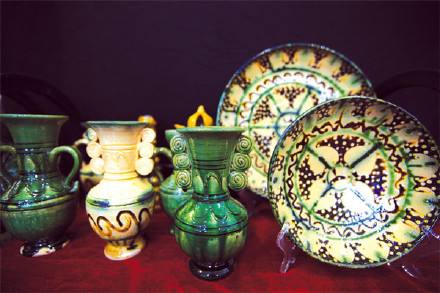A Memory of Thousand Years of the Western Regions
4 min readI have always believed that Kashgar is a living gene bank about the memory of the ancient Western Regions. The hathpace residence that has existed till today shows the enormous vitality of this memory I was really amazed by the hathpace residence when I saw it for the first time. The deep yellow rammed earth has restored the color of the land of Xinjiang, and caters to the original temperament of Xinjiang oasis. This is the color and code of Xinjiang. Earth pottery also has such a color and temperament. was led into the ancient space when I saw the beautiful shape of the earth pottery.

Making potteries
Earth pottery in Kashgar
The narrow Kuoziqiyabeixi Lane has long become famous card to show the traditional handicrafts of hathpace residence Kuoziqiyabeixi means earth pottery on a high cliff. This name reveals what this lane is famous for. Earth pottery is the signboard and the entire business here. Located on the highest cliff which is hundreds of meters above the ground in the old city proper of Kashgar, Kuoziqiyabeixi lane is inhabited by 603 households with 2 ,450 people, all of whom are Uygurs.

Zunun Asimjan, the owner of No. 531 was a famous earth pottery bearer. Earth pottery has been included in the intangible cultural heritage at the level of the autonomous region.
The culture represented by earth pottery, in my view, is at least not inferior to the cultural relics in museums. Yasheng, a staff from Kashgar Bureau of Culture and Sports, who was accompanying us, had already introduced to us about Zunun Asimjan: “Their family members have been engaged in making earth pottery for generations. As far as we know, there have been six generations. The first generation is Supi, the second is Zunun, and the following generations are respectively Tiyifu, Asim, Zunun Asimjan and Tursunkari.”Of the folk bearers in various regions of Xinjiang, those who have complete inheriting pedigree are of large number. The family of Zunun is a good example. Zunun Asimjan is locally famous for his technique for making earth pottery. Watching the various earth pottery handicrafts displaying at the doorway, I couldn’t help sighing. These ancient handicrafts still show such an enormous vitality after the passage of time.

Zunun Asimjan began to make earth pottery. Yasheng watched him stirring the mud, explaining to us, “The procedure of making earth pottery is basically same as that of the inland. It includes preparing the earth, stirring the mud, sealing the mud kneading the mud, shaping, enameling, firing and manufacturing.” Then he continued to say, smiling, “Our earth pottery is good mainly because our earth is good. On one of the earth layers on the high cliff is one sort of earth called segezi. This earth is fine and sticky. It is the best earth for making earth pottery. It is said that 800 years ago, an artisan who made earth pottery discovered it, so he built the first earth pottery workshop on the high cliff. After that, many earth pottery artisans began to build workshops on the high cliff and these workshops were passed down till today.
Earth pottery is actually a symbol of culture. I have seen a lot of Neolithic faience in the museums of Southern and Northern Xinjiang. The beauty of these pieces of lively and elegantly shaped faience made from 3,000 BC to 2,000 BC was so touching. They showed that the people in the remote primitive society had already had the pursuit of beauty in life.

The mud was injected with life by their skillful hands and became an important tool in their daily lives. Foreign archeologists of early 20tn century believed unanimously that Chinese faience was the origin of civilization and it was originated from Mesopotamia. Chinese archeologists found the origin of faience in the Siba culture of Gansu, the Qijia culture,and the Hongshan culture. In this period, a group of people moved to Komul basin from the land west of the Yellow River and brought with them the faience culture, typically characterized by double-eared pottery jar. The patterns of faience were spread to Komul from the upper reach of the Yellow River via the Hexi Corridor. This origin directly influenced Komul in the east of Xinjiang where the morning twilight of the Western Regions faience began to show and finally spread to the entire Western Regions. Pottery culture appeared in all the birthplaces of culture in the world. The ancient potteries unearthed in Southern and Northern Xinjiang and Eastern Xinjiang were so magnificent. During thousands of years from the ancient times to modern era, various ethnic groups in Xinjiang have inherited and developed their colored earth pottery technique left by ancient people, and gradually formed earth pottery of unique styles. The cultural significance of earth pottery was shown by the fact that it had to some extend caused Chinese and foreign archeologist to study the origin of Chinese civilization.








